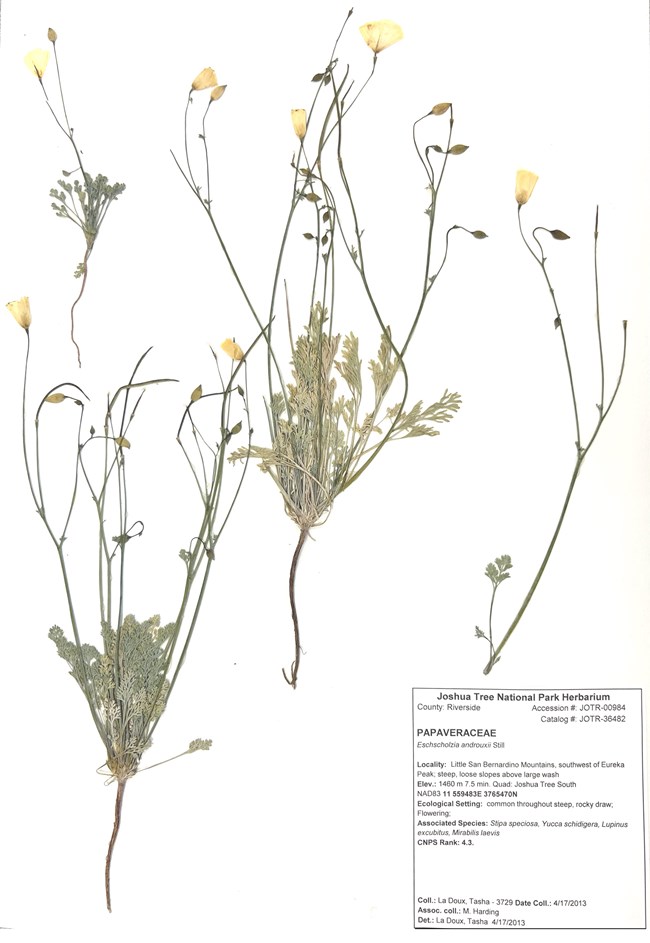Last updated: April 27, 2023
Article
The Joshua Tree National Park Herbarium

NPS / Cynthia Berger
"A Collection of Plants"
The first person to press plants flat, dry them, and bind the specimens in a book for future study was a 16th-century Italian botanist. The practice caught on in Europe, where the books were called “herbaria.”
But the noted botanist Carl Linnaeus, working in the 1700s, found it difficult to sort specimens when they were bound in a book. He started storing the unbound sheets of paper with their mounted plants in cabinets. Facilities that house plant collections came to be known as “herbaria”—the name scientists still use today.
History of the Park Herbarium
In 1941, James E. Cole, the first superintendent of Joshua Tree National Monument, collected about 250 specimens to start an herbarium. He knew the information stored in the herbarium cabinets would help resource managers protect biological diversity.
That's because herbarium specimens, called "vouchers," are labeled with useful details like the location, elevation, and habitat where the plant was found (Fig. 1). The combination of a physical specimen and these data makes every herbarium a treasure trove of information for taxonomic and ecological studies.
In the 1990s, the National Park Service launched an Inventory and Monitoring (I&M) Program to ensure the protection of natural resources in parks “into the 21st century and beyond.” One goal of the I&M program was to document, in scientifically credible ways, more than 90 percent of all species found in each park—including the vascular plants.
At the time, the Joshua Tree National Park (JTNP) herbarium contained about 660 specimens, representing just 35 percent of the park's plant species. Over the past 20 years, botanists have worked hard to meet I&M goals with fieldwork to produce a complete floristic inventory.
Today, the herbarium, which is located at park headquarters in Twentynine Palms, CA, houses more than 95 percent of the nearly 750 vascular plant species known to occur in the park. An online database for the herbarium's more than 6500 speciments is available to researchers (and the general public) through the Consortium of California Herbaria: https://www.cch2.org/portal/.
A Resource for Discovery
The JTNP Herbarium (and the inventory program that supports it) have contributed to many discoveries over the past 20 years—including seven newly described species.
The story of one unassuming aster-like plant is typical. A botanist first collected specimens in 2012, identifying it as a member of the genus Heterotheca, but noting that it had some unusual features. Not long after, a researcher studying the entire genus reviewed the park’s specimens…and concluded that the herbarium held an entirely new species, now named for the park: Heterotheca joshuana, the Joshua tree goldenaster. The herbarium holds the Joshua tree goldenaster "type specimen," a particularly important kind of voucher used to establish the identity of a new species.
The story is similar for the Joshua tree poppy, Eschscholzia androuxii (Fig. 1). Botanist Shannon Still identified it as a new species after consulting the park herbarium for his dissertation research. Says Still, “This work highlights the value that herbarium collections play in cataloging, understanding, and conserving our biological diversity."
Sadly the herbarium also documents losses. It holds specimens collected in the park long ago of the desert oak tree, Quercus palmeri, and the shrub Ceanothus perplexans. Despite recent extensive searches, botanists have never relocated either species. They likely grew in isolated places and were destroyed in wildfires.
Documenting What Grows Where
The herbarium helps meet the NPS goal of protecting and maintaining biological diversity in the park by documenting what grows where. In the past two decades, botanists have added 170 species to the park's inventory of vascular plants; these species were not known to grow in the park until they were discovered during field surveys. Importantly, 19 of the new species are classified as rare in California, such as Darlington's blazing star (Mentzelia puberula), first collected in 2010.
In all the herbarium holds vouchers for 55 rare plant species and documents more than 800 locations where they grow. Two of these species are federally listed: Parish’s fleabane, Erigeron parishii (threatened), and the triple-ribbed milkvetch, Astragalus tricarinatus (endangered).
The milkvetch was known from only one 1975 voucher; the herbarium now documents 19 populations, including the third largest population known for the species. For both of these rare plants, the park is an important refugium, and the vouchers are being used in conservation studies to address the long-term viability of the species.
The herbarium also documents range expansions—when a plant begins to grow in new geographic locations. For example, in 2008, park botanists vouchered Hymenopappus filifolius var. lugens, not previously known to occur in deserts.
Future Growth
In the years ahead, botanists can consult park herbarium specimens to work out the historic and current distribution of plant species—to learn which plants are becoming more widely distributed, and which are seeing their ranges contract. As climate change affects plant communities in JTNP in the future, this information will be invaluable for park managers.
